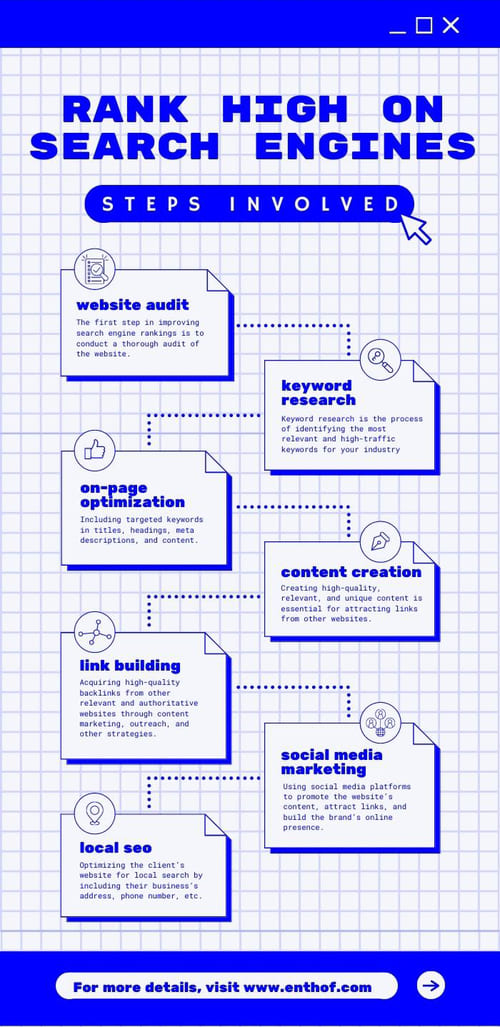A website that doesn’t rank high on search engines may still have some value, but its potential impact and reach will likely be limited. Improving a website’s search engine rankings is crucial for businesses that want to increase their online visibility and attract more organic traffic. However, achieving a top ranking on search engines like Google is no easy feat. It requires a comprehensive and ongoing process of optimizing website content, technical factors, backlinks, and user experience. In this blog post, we will discuss the essential steps involved in ranking a client’s website high on search engines and provide detailed explanations and actionable tips for each step.
Few Reasons Why Websites With Lower Ranks Don’t Do Well
- Limited Visibility: Websites that rank high on search engines are more visible to potential visitors, while those that do not are harder to find. Without good search engine rankings, a website is likely to receive less traffic.
- Reduced Credibility: High search engine rankings can help establish a website’s credibility, as they are seen as an indicator of quality and authority. Conversely, a website that does not rank well may be seen as less credible or trustworthy.
- Missed Opportunities: If a website doesn’t rank high on search engines, it may miss out on opportunities to reach potential customers or visitors. For example, if a business’s website does not show up on the first page of search results for relevant keywords, potential customers may not find it when searching for products or services.
- Reduced Revenue: Websites that rely on traffic to generate revenue, such as through advertising or e-commerce sales, may suffer from lower revenue if they don’t rank well on search engines.
Overall, a website that doesn’t rank high on search engines can still have some value, but its potential impact and reach will likely be limited. It’s important to take steps to improve search engine rankings to maximize a website’s effectiveness.
Ranking Your Website High On Search Engines
There are many strategies and techniques that can help improve a website’s ranking on search engines. Here are a few key ones:
Keyword Research:
Identify the keywords and phrases that people are searching for related to your website’s topic or content. Use these keywords in your website’s content and meta tags.
On-page Optimization:
Optimize your website’s pages for search engines by including relevant keywords in titles, headings, meta descriptions, and content. Ensure your website’s design is mobile-friendly and easy to navigate.
Content Creation:
Regularly create high-quality, relevant, and unique content that incorporates targeted keywords. This will help attract links from other websites, which is an important factor in search engine rankings.
Link Building:
Acquire backlinks from other websites that are relevant and authoritative. This can be done by creating great content, reaching out to other websites, or utilizing broken link-building strategies.
Social Media Marketing:
Utilize social media platforms to promote your website’s content, attract links, and build your brand’s online presence.
Local SEO:
Optimize your website for local search by including your business’s address, phone number, and other relevant information in your website’s content and meta tags.
It’s important to note that improving search engine rankings is an ongoing process that requires time, effort, and ongoing analysis and adjustments. It’s also important to follow best practices and avoid using spammy or unethical techniques that can result in penalties or even being banned from search engines.
Steps Involved To Rank High On Search Engines Like Google.com

If an agency is tasked with ranking their client’s website high on search engines like Google.com, there are several steps they can take to achieve this goal. Here is a general overview of the process:
Website Audit:
The first step in improving search engine rankings is to conduct a thorough audit of the client’s website. This will help identify technical issues, on-page optimization opportunities, and other areas that need improvement. The website audit should include:
- Checking for broken links, duplicate content, and other technical issues that can negatively affect search engine rankings.
- Analyzing website load speed, mobile-friendliness, and ease of navigation.
- Assessing website content for relevance, uniqueness, and quality.
- Reviewing website metadata, including titles, descriptions, and headers.
Keyword Research:
Keyword research is the process of identifying the most relevant and high-traffic keywords for the client’s industry and target audience. According to Search Engine Journal, “the impact on SEO has been a shift in keyword research toward a deeper understanding of what words mean in different contexts and especially as a part of an overall topic.” The keyword research process should include:
- Analyzing competitor websites to identify their targeted keywords and areas of opportunity.
- Using keyword research tools such as Google Keyword Planner to identify high-traffic keywords.
- Prioritizing keywords based on relevance, search volume, and competition level.
On-page Optimization:
On-page optimization involves optimizing the client’s website pages for search engines by including targeted keywords in titles, headings, meta descriptions, and content. The on-page optimization process should include:
- Including targeted keywords in page titles, headers, and meta descriptions.
- Using keywords naturally and effectively in website content.
- Ensuring website design is mobile-friendly, fast-loading, and easy to navigate.
- Optimizing website images by using descriptive file names, alt tags, and captions.
Content Creation:
Creating high-quality, relevant, and unique content is essential for attracting links from other websites, which is an important factor in search engine rankings. The content creation process should include:
- Creating high-quality, informative content that addresses the needs and interests of the target audience.
- Ensuring content is optimized for targeted keywords and includes engaging headings, subheadings, and visuals.
- Promoting content on social media and other channels to attract links from other websites.
Link Building:
Link building involves acquiring high-quality backlinks from other relevant and authoritative websites through content marketing, outreach, and other strategies. According to Semrush, Google and other major search engines consider backlinks as “votes of confidence” for the website getting the links. The link-building process should include:
- Conducting competitor analysis to identify relevant and authoritative websites in the client’s industry.
- Creating high-quality, informative content that attracts links from other websites.
- Reaching out to other websites to request backlinks or participate in guest posting opportunities.
- Promoting content on social media and other channels to attract links from other websites.
Social Media Marketing:
Social media marketing involves using social media platforms to promote the client’s website’s content, attract links, and build the client’s brand’s online presence. The social media marketing process should include:
- Developing a social media strategy that targets the client’s audience and goals.
- Creating engaging and shareable content that resonates with the target audience.
- Utilizing social media advertising to increase reach and attract new followers.
- Monitoring social media engagement and responding to comments and feedback.
Local SEO:
Local SEO involves optimizing the client’s website for local search by including their business’s address, phone number, and other relevant information in the website’s content and meta tags. The local SEO process should include:
- Including the client’s business address and phone number on the website’s homepage and contact page.
- Creating a Google My Business listing and optimizing it with accurate business information.
- Ensuring website content includes location-specific keywords and information.
- Encouraging online reviews and ratings from satisfied customers.
Monitoring and Reporting:
The final step in improving search engine rankings is to continuously monitor the client’s website’s performance and search engine
It’s important to note that the specifics of these steps may vary depending on the client’s industry, competition, and other factors. The agency should also follow best practices and avoid using spammy or unethical techniques that can result in penalties or even being banned from search engines.
Will This Process Guarantee Top Ranking For The Website
Unfortunately, there is no guarantee that this process will result in a top ranking for the client’s website. The search engine ranking algorithms used by Google and other search engines are complex and constantly evolving, and many factors can affect search engine rankings, including competition, search volume, user behavior, and technical factors.
However, following this process can certainly improve the client’s website’s search engine rankings over time by addressing key factors that influence search engine rankings, such as website content, technical optimization, backlinks, and user experience. It is important to note that improving search engine rankings is a long-term process that requires ongoing effort and adaptation to changes in search engine algorithms.
Additionally, it is important to have realistic expectations about search engine rankings. Achieving a top ranking for highly competitive keywords in a short amount of time is often difficult, if not impossible. Instead, a more achievable goal may be to improve search engine rankings gradually over time by targeting relevant and less competitive keywords and focusing on building high-quality content and backlinks that provide value to the target audience.
Get on a consultation call with Enthof Creatives to make your website higher on Google.com and other search engines.


